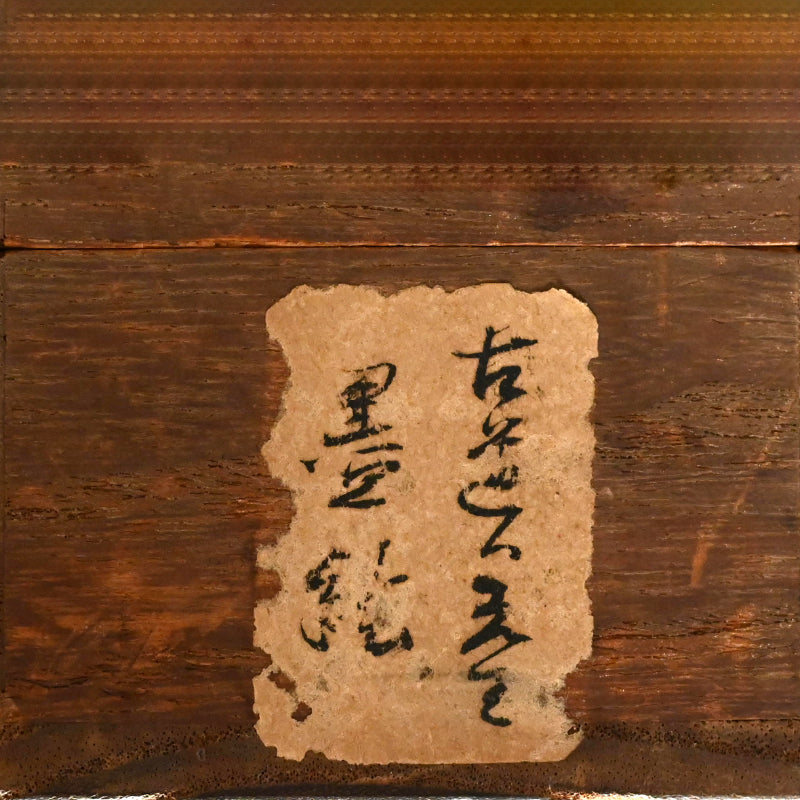Hermitage in the Bamboo Grove A ー福田 古道人 “竹林経書居図”
Hermitage in the Bamboo Grove A ー福田 古道人 “竹林経書居図”
Item Code: 古35
Couldn't load pickup availability
In the collection, two hanging scrolls by Fukuda Kodojin, while composed almost identically, reveal dramatically different expressive intentions through brushwork, ink handling, and spatial rhythm. They offer a rare glimpse into Kodojin’s evolving approach to literati painting, and his subtle negotiation between disciplined restraint and spontaneous expression. In this first scroll, the brushwork is restrained, lyrical, and highly controlled. Kodojin builds the cliffs and mountains with crisp, vertical strokes, carefully modulated in tone and moisture. The bamboo grove below is drawn with precise, elegant leaf clusters and tall, evenly spaced stalk. The little thatched hut beside the bamboo, its circular window revealing a solitary scholar within, evokes the archetypal image of the recluse in harmony with nature. Atmospherically, this painting feels quiet and ascetic: the ink tones are cool and the spatial intervals generous, inviting the viewer into a tranquil reverie. Every brush mark is deliberate, revealing the artist’s reverence for tradition and composure of mind. Ink on paper, in deep green patterned silk border with dark hard-wood rollers, wooden box. The scroll is 48 x 200.5 cm (19 x 79 inches) and is in overall excellent condition.
It is as though Kodojin is demonstrating in visual form the very ideal expressed in many of his poems: that mastery of form ultimately leads to freedom from form. In literati terms, the first work is a painting of li (principle), the second of qi (vital energy). One stands within the tradition; the other dissolves into it. Together they form a profound dialogue between the classical and the modern, intellect and spirit — an artistic summation of Kodojin’s lifelong cultivation of both brush and being.
Fukuda Kodojin (1865-1944) was an eccentric self-taught artist, his status as a poet, calligrapher and literati artist has reached legendary status. Born at a time of great change (4 years before the final fall of the Edo Government), he lived through the westernization of Meiji, Taisho Democracy, the rise of Imperialism and final defeat of the Showa eras. He was part of a small group of artists existing outside conventional circles in pre-war Japan. He moved to a village outside of Kyoto in 1901, where he supported himself and his family by privately tutoring those who wished to learn Chinese-style poetry. Kodojin was simply a scholar. His poetry, painting, and calligraphy all stem from a life-long cultivation of the mind. He was said to have taken the time just before his death to destroy the large portion of his own remaining work, leaving only that which must have met some personal criteria. Kodōjin’s paintings and calligraphy survive mainly in private collections, but significant works can be found in the collections of the British Museum, Freer Sackler Gallery of the Smithsonian Institute, Honolulu Museum of Art, Houston Museum of Fine Arts, Kumamoto Prefectural Museum of Art, Minneapolis Institute of Art, Museo Kaluz, New York Metropolitan Museum of Art, Portland Art Museum, Seattle Art Museum, St. Louis Art Museum, Tanabe City Museum of Art and Wakayama Prefectural Museum of Art among others including such well known Private collections as the Cowles Collection, Hakutakuan Collection, Manyoan Collection and Welch Collection. Twenty five paintings by the artist formed a private exhibition (from the Gitter-Yelen collection) at the New Orleans Museum of Art in 2000. In recent years, exhibitions such as The Last Master of the Literati Tradition: Fukuda Kodōjin (Minneapolis Institute of Art, 2023) have brought renewed attention to his achievement. For more on his life see the book Old Taoist, or Unexplored Avenues of Japanese Painting.
Share




























